#Bodhi Day rituals
Explore tagged Tumblr posts
Text
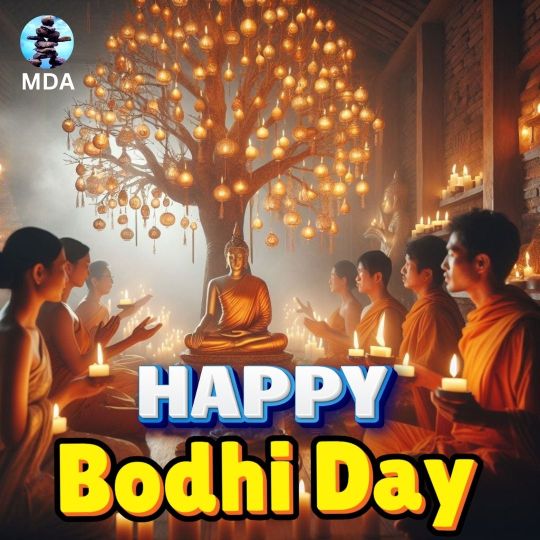
"HAPPY BODHI DAY"#trending#viral
Happy Bodhi Day marks the day when Siddhartha Gautama, known as Lord Buddha, attained enlightenment under the Bodhi Tree in Bodh Gaya, India. This day symbolizes the awakening of wisdom, compassion, and mindfulness, inspiring millions to reflect on their spiritual journeys.
Call:7799799221
Website:www.manasadefenceacademy.com
#HappyBodhiDay #BodhiDay #LordBuddha #BodhiTree #EnlightenmentDay #BuddhismTeachings #SpiritualWisdom #MindfulnessJourney #BuddhaEnlightenment #BodhiDayCelebrations
#Happy Bodhi Day#Bodhi Day 2024#Enlightenment of Lord Buddha#Bodhi Tree significance#Bodhi Day rituals#Buddhism and Bodhi Day#Spiritual significance of Bodhi Day#History of Bodhi Day#Meditation on Bodhi Day#Mindfulness practices#Buddha’s enlightenment story#Bodhi Day importance#Celebrating Bodhi Day#Bodhi Tree history
0 notes
Text
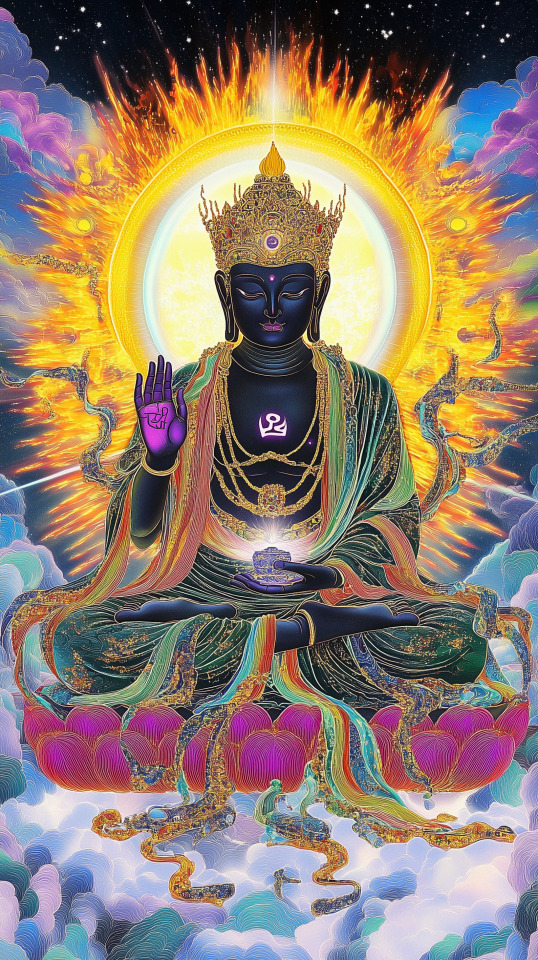
Maha Vairocana, Cosmic Sun Buddha Talon Abraxas
Vairocana is one of the Five Dhyani Buddhas created by Adhi Buddha. In Sanskrit, the name vairocana means "luminous" or "embodiment of light". In Chinese, Japanese, Tibetan, and Vietnamese Buddhism; Vairocana is called as Dari Rulai / Piluzhena Fo, Dainichi Nyorai, Nampar nangdze / Namnang, and Dai Nhat Nhu Lai respectively. In the above mentioned Buddhism, the Buddha is seen as the embodiment of Buddhist concept of Emptiness. While in Mahayana and Vajrayana Buddhism, Vairocana is considered as a Primordial Buddha and is located at the center. He is also referred to as the "great illuminating one," “the Life force that illuminates the universe," and importantly, "all-encompassing Buddha". Therefore, Vairocana is mentioned in different sutras.
In Brahma Net Sutra, it is written that Vairocana Buddha is seated on a top of a lotus pedestal and surrounding of that lotus there are thousands of flowers. These flowers are the Sakyamuni Buddhas, which supports a hundred million worlds. It is also mentioned that Sakyamuni Buddha is born in each world. They all attain Buddhahood at the same time under Bodhi tree. All these Sakyamuni Buddhas have Vairocana as their original body.
In Flower Garland Sutra, also called Avatamsaka, Vairocana is presented as the ground of being and the matrix from which all phenomena emerges. He is regarded as the Dharma Body of the historical Buddha (Siddhartha Gautama).
In Samantabhadra Meditation Sutra, also called as the "Sutra of Meditation on the Bodhisattva Universal Virtue", Vairocana is mentioned as a Buddha who has similar characteristics as that of Sakyamuni Buddha. And he roams around a place called "Always Tranquil Light".
Lotus Sutra, also called Saddharma Pundarika Sutra, is composed in the first century B.E.C. In this sutra, it is believed that Buddhas are said not to die even though their physical bodies degenerate. It is also mentioned that Buddha has explained that he has always lead the beings to their salvation and will always continue to do so. Therefore he is considered as the most sublime or truest reality in the universe.
In Mahavairocana Sutra, Vairocana is depicted as the universal Buddha from whom all other Buddha are originated. He is also represented as the source of enlightenment who helps others to be free from causes and conditions. It is also mentioned that Vairocana taught about the Dharma to Vajrasattva but it was incomprehensible to learn for them. That's why Vairocana provided esoteric techniques and rituals to help Vajrasattva to conceptualize the Dharma beyond verbal form. Therefore, Vairocana is also referred as a teacher, without whom there would have been no Buddhism, and also there would not have the path to enlightenment.
Even though Vairocana is mentioned in various Sutras, the doctrine of Vairocana Buddha is largely based on the teachings of the Mahavairocana Sutra. This Sutra is thought to be the earliest comprehensive manual of Buddhist tantra. It is believed that this Sutra is composed in the 7th Century.
Iconography
Vairocana Buddha is often depicted as seated in the lotus pedal which is supported by a pair of two great lions. Symbolically, it is represented that when the lions roar, all other remains silent and listens to him. Likewise, when one is spreading Buddha's teachings almost all others remains silent and listens to the Buddha's valuable teachings. When Vairocana Buddha is depicted as meditating, it is believed that the image of Vairocana helps to transform the delusion of ignorance into the wisdom preached by the Dharma. Similarly, when Gautama Buddha turned the wheel of Dharma, it illuminated the hearts of people which was darkened by ignorance.
When Vairocana Buddha is depicted in Buddha statues, he is also shown in Dharma chakra mudra. This mudra is formed when the thumb and index finger of both hands touch at their tips to form a circle. The left hand faces inward which covers the right hand which is facing outward and the hands are held against the chest. The remaining fingers of both hands remain extended.
Since Vairocana is believed to be the aggregate of all the Dhyani Buddhas. Therefore, He has the complexion of pure white since white produced when all the colors merge together. His symbol is the dharma wheel. When all Five Dhyani Buddhas are depicted together in a mandala, Vairocana is placed in the center. He is often shown larger than other Buddhas around him. He is Lord of Akanistha Ghanavyuha Pure land which existed in the center. His consort is White Tara and his Bija starts with Om. In Vajrayana Buddhism, it is believed that Vairocana Buddha helps to overcome ignorance and delusion when a person chants his mantra.
Vairocana Sadhana - Diamond Realm:
30 notes
·
View notes
Text
Buddhism: The Journey of the Mind and Spirit to Enlightenment

Buddhism is one of the world’s oldest and most influential religions and spiritual philosophies, with roots dating back to the sixth century BCE in India. Founded by the teachings of Siddhartha Gautama, the Buddha, Buddhism has spread throughout Asia and beyond, shaping the cultures, art, literature, and spiritual practices of many societies. More than a religion in the traditional sense, Buddhism offers a philosophical and ethical path to self-knowledge, detachment, and the pursuit of enlightenment. This article explores the origins, fundamental teachings, and lasting impact of Buddhism.
The Origins of Buddhism: The Life of Siddhartha Gautama
Siddhartha Gautama was born around 563 BCE in Lumbini, present-day Nepal, into a royal family. From an early age, he was sheltered from the painful realities of life, living in a palace surrounded by luxury. However, upon leaving the palace and seeing the suffering of the world—represented by the visions of an old man, a sick man, a corpse, and an ascetic—Siddhartha realized the impermanence of life and decided to abandon his privileged existence to seek an answer to human suffering.
After years of spiritual searching, Siddhartha practiced deep meditation, asceticism, and studied with various teachers, but it was under a fig tree, known as the Bodhi Tree, that he finally achieved enlightenment, becoming the Buddha, which means “The Awakened One.” He spent the rest of his life teaching the principles he discovered, offering a path to the cessation of suffering, known as the Eightfold Path.
The Fundamental Teachings of Buddhism
Buddhism is based on a series of teachings that seek to guide practitioners in understanding the nature of life and in the pursuit of enlightenment. Among the central tenets are the Four Noble Truths and the Eightfold Path.
The Four Noble Truths:
The Truth of Suffering (Dukkha): Life is permeated by suffering, dissatisfaction, and impermanence.
The Truth of the Origin of Suffering: Suffering is caused by craving and attachment, which lead to frustration and pain.
The Truth of the Cessation of Suffering: It is possible to overcome suffering through detachment and understanding.
The Truth of the Path to the Cessation of Suffering: The Eightfold Path is the practical route leading to liberation.
The Eightfold Path:
Right Understanding: Knowing the reality of the Four Noble Truths.
Right Thought: Cultivating the intention of renunciation, goodwill, and nonviolence.
Right Speech: Avoiding lies, slander, hurtful words, and idle talk. - Right Action: Behaving ethically, refraining from killing, stealing, or sexual misconduct.
Right Livelihood: Choosing an occupation that does not cause harm to other beings.
Right Effort: Striving to avoid negative thoughts and cultivating positive ones.
Mindfulness: Maintaining awareness of the body, feelings, mind, and phenomena.
Right Concentration: Practicing meditation to achieve higher states of mind and enlightenment.
Types of Buddhism: Diversity in Practices and Traditions
Buddhism expanded rapidly after the Buddha's death, dividing into several schools and traditions that reflected different interpretations of the original teachings.
Theravada (The Way of the Elders): Predominant in Southeast Asia (Thailand, Myanmar, Sri Lanka), this tradition closely follows the Buddha's original teachings, with an emphasis on monastic practice and meditation.
Mahayana (The Great Vehicle): With roots in China, Japan, and Korea, Mahayana emphasizes compassion and the path of the bodhisattva—one who seeks enlightenment not just for oneself but to help all beings.
Vajrayana (The Diamond Vehicle): Developed primarily in Tibet, it combines elements of Mahayana Buddhism with esoteric rituals and tantric practices to achieve enlightenment quickly.
Zen Buddhism: Originating in China (as Chan) and later developed in Japan, Zen focuses on meditation (zazen) and direct experience of reality, emphasizing simplicity and self-knowledge.
Buddhist Philosophy: Karma, Samsara, and Nirvana
Buddhism is not just a series of rituals, but a profound philosophy that addresses the nature of the mind and the universe. Central to this is the concept of karma – the idea that intentional actions, good or bad, generate consequences that shape the cycle of birth, death and rebirth, known as samsara. The ultimate goal of the Buddhist practitioner is to attain nirvana, a state of liberation and complete cessation of suffering.
Legacy and Influence of Buddhism
Buddhism’s impact has transcended religion, profoundly influencing the art, literature, politics and philosophy of many cultures. Buddhist monasteries were centers of learning, preserving sacred texts and
Legacy and Influence of Buddhism
Buddhism’s impact has transcended religion, profoundly influencing the art, literature, politics, and philosophy of many cultures. Buddhist monasteries were centers of learning, preserving sacred texts and promoting education. Buddhist iconography—from serene statues of the Buddha to intricate mandalas—continues to inspire.
In the West, Buddhism gained popularity in the 20th century, especially through meditation and mindfulness, which were adapted as wellness practices separate from religious contexts. Figures such as the Dalai Lama and Thich Nhat Hanh have become global ambassadors for peace and Buddhist philosophy.
Buddhism in the Modern World
Today, Buddhism continues to grow and adapt, with an estimated half a billion followers worldwide. Buddhist traditions remain vibrant, from remote monasteries in the Himalayas to urban centers in the West. In a world marked by stress and the search for meaning, the Buddha’s teachings on compassion, wisdom, and self-mastery resonate as a guide to a more conscious and harmonious life.
Buddhism is not just a religion; it is a philosophy that offers a path to a deeper understanding of the mind and existence. With its timeless teachings, Buddhism invites each individual to explore their own experience, cultivate compassion, and seek true inner freedom.
16 notes
·
View notes
Photo
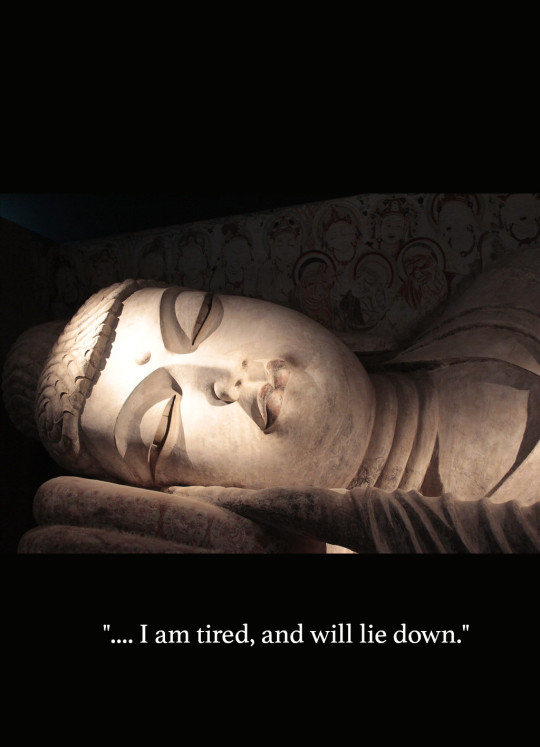
Legends and myths about trees
Trees in Buddhism (3)
Sal tree (Shorea robusta) – the Nirvana
In Buddhism, there is an important day called 'Sanbutsuki (3 anniversaries of the Buddha)', which commemorates three major milestones in the Buddha's life.
These are Buddhist rituals of the Nativity on 8 April, when Buddha was born, the Jodo-e (becoming a Buddha) on 8 December, when he attained enlightenment, and the Nirvana on 15 February, when he passed away.
The Buddha's death is believed to have occurred on 15 February of the lunisolar calendar in China and Japan, and in many places it is now held on 15 March.
According to Buddhist tradition, the Buddha was lying between a pair of sal trees when he died:
Then the Blessed One with a large community of monks went to the far shore of the Hiraññavati River and headed for Upavattana, the Mallans' sal-grove near Kusinara. On arrival, he said to Ananda (Ref1), the chosen disciple, "Ananda, please prepare a bed for me between the twin sal-trees, with its head to the north. I am tired, and will lie down. (DN16; Nirvana Sutra)"
When the Buddha died in Kusinara, there were 4 or 8 sal trees on the 4 corners of his bed. They were said to have bloomed at the same time, then quickly withered and turned white, just like a flock of cranes.
In Buddhism, the brief flowering of the sal tree is used as a symbol of impermanence and the rapid passing of glory. The sal tree is also said to have been the tree under which Kondana and Vessabhu, respectively the fifth and twenty fourth Buddhas preceding Gautama Buddha, attained enlightenment.
The sal tree (shorea robusta, sāla, shala, sakhua, or sarai), is a species of tree in the family Dipterocarpaceae. The tree is native to India, Bangladesh, Nepal, Tibet and across the Himalayan regions.
The sal tree is mythologically classified as a 'tree of life', symbolising resurrection, rebirth and rejuvenation, but in Buddhism it is one of the three most sacred trees, symbolising parinirvana, as the Buddha died under two sal trees in a row.
The three most sacred Buddhist trees are:
Ashoka tree: the tree where the Buddha was born (Ref).
Bodhi tree: the tree where the Buddha attained enlightenment
Sal tree: the tree where the Buddha died.
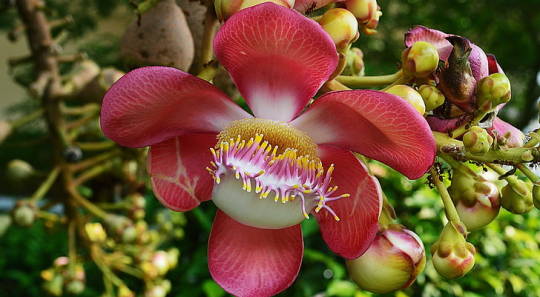
木にまつわる伝説・神話
仏教の樹木 (2)
沙羅双樹 (サラソウジュ) 〜涅槃会 (ねはんえ)
仏教には、ゴータマ・ブッダの生涯における3つの大きな節目を記念する「三仏忌 (さんぶつき)」という大切な日がある。
それが、ブッダが生まれた4月8日の降誕会 (こうたんえ)、悟りを開いた12月8日の成道会(じょうどうえ)、そして入滅した2月15日の「涅槃会(ねはんえ)」。
ブッダの入滅は中国や日本では旧暦2月15日とされ、現在は3月15日に行なわれているところが少なくない。
また、仏教の伝統によると、ブッダは入滅したとき、一対の沙羅双樹 (サラソウジュ) の間に横たわっていた。
その後、大勢の僧侶たちの中から選ばれたアーナンダ(参照1)はヒラニャーヴァティ川の向こう岸に行き、クシナラ近くのマッラ族の沙羅樹の林、ウパヴァッタナへ向かった。到着すると、ブッダはアーナンダに言った。「アーナンダ、2対の沙羅双樹 (サラソウジュ) の間に、頭を北に向けた寝床を用意してください。私は疲れているので、横になります。(DN16; 大般涅槃経)」
ブッダがクシナガラで死去したとき、臥床の四辺に4双8本の沙羅双樹 (サラソウジュ)があった。時じくの花を咲かせ、たちまちに枯れ、白色に変じ、さながら鶴の群れのごとくであったという。
仏教では、沙羅双樹 (サラソウジュ)の木の短い花は、無常と栄光の急速な通過の象徴として使用されることもある。また、沙羅双樹 (サラソウジュ) は、ゴータマ・ブッダに先立つ5番目の仏陀であるコーナニャーと24番目の仏陀であるヴェッサブーが悟りを開いた木であると言われている。
沙羅双樹 (サラソウジュ)はフタバガキ科の樹木の一種で、インド、バングラデシュ、ネパール、チベット、ヒマラヤ地方に自生している。
沙羅双樹 (サラソウジュ)は神話学的には復活・再生・若返りの象徴である「生命の木」に分類されるが、仏教では二本並んだ沙羅の木の下で釈尊が入滅したことから般涅槃の象徴とされ、仏教三大聖樹のひとつである:
無憂樹: 釈迦が生まれた所にあった樹木(参照)
印度菩提樹:釈迦が悟りを開いた所にあった樹木
娑羅双樹:釈迦が亡くなった所にあった樹木
#trees#tree legend#tree myth#trees in buddhism#sal tree#buddha#nirvana#ananda#buddhist rituals#philosophy#nature#art#sacred trees
171 notes
·
View notes
Text
spiritual Tours India By The Taj In India Company

The Taj In India Company offers spiritual tours of India.
India, with its deep spiritual origins and numerous religious traditions, offers a shelter for people seeking spiritual enlightenment and inner tranquility. The Taj In India Company's mindfully curated spiritual excursions provide a one-of-a-kind opportunity to discover India's rich spiritual legacy. Whether you're looking for tranquility, hoping to connect with your inner self, or simply interested about India's spiritual practices, these trips offer an immersive experience that strikes the soul.
Understanding Spiritualism in India For thousands of years, India has been a place for spiritual growth and development. The country is home to a plethora of religions, including Hinduism, Buddhism, Jainism, and Sikhism, each presenting an own route to spiritual discovery. The Taj In India Company's spiritual trips are designed to bring you to the essence of Indian spirituality through visits to sacred locations, temples, ashrams, and discussions with spiritual experts.
Why Should I Take a Spiritual Tour in India? Spiritual excursions in India provide more than just scenery; they allow you to go on an inner journey. The Taj In India Company guarantees that your spiritual experience is both personal and transformative. You will visit ancient temples, relax in tranquil ashrams, and participate in centuries-old traditions. These vacations are ideal for people seeking to unplug from the bustle of everyday life and reconnect with their true selves.
Key Destinations in Spiritual Tours 1. Varanasi is the spiritual heart of India. Varanasi, also known as Kashi, is one of the world's oldest cities and considered India's spiritual heart. The Taj In India Company's spiritual tour includes a visit to this hallowed city, where you can see the beautiful Ganga Aarti on the banks of the Ganges River, see historic temples, and take a boat ride at daybreak. Varanasi's environment is infused with spirituality, making it a must-see destination on any spiritual journey.
2. Rishikesh - The Yoga Capital of the World Rishikesh, located in the Himalayan foothills, is known as the world's Yoga Capital. This tranquil village is a popular destination for yoga and meditation retreats, attracting spiritual seekers from all over the world. The Taj In India Company's tour allows you to practice yoga by the Ganges, relax in peaceful ashrams, and visit the famed Parmarth Niketan Ashram. Rishikesh's tranquil atmosphere is ideal for introspection and spiritual development.
3. Bodh Gaya: The Land of the Buddha's Enlightenment Bodh Gaya is a key pilgrimage site for Buddhists since it is where Siddhartha Gautama acquired enlightenment and became the Buddha. The spiritual tour offered by the Taj In India Company includes a visit to the Mahabodhi Temple, a UNESCO World Heritage site, where you can meditate under the Bodhi Tree, which is thought to be a direct descendent of the tree where Buddha pondered. This encounter is deeply touching and provides a strong link to Buddhist spirituality.
4. Amritsar is the spiritual center of Sikhism. Amritsar, home of the Golden Temple, is Sikhism's spiritual and cultural center. The Taj In India Company's tour includes a visit to this majestic temple, where you may help out in the communal kitchen (Langar), which serves thousands of people free meals every day. The serene environment of the Golden Temple, along with the Sikh community's commitment, make for a profoundly amazing spiritual experience.
5. Haridwar, the Gateway to the Gods. Haridwar, one of Hinduism's seven holiest locations, is located where the Ganges River descends from the Himalayas. The Taj In India Company's spiritual tour includes watching the evening Ganga Aarti at Har Ki Pauri, a ritual that includes chanting, fire, and river offerings. This ceremony is a tremendous display of dedication that will leave an indelible mark on your spiritual journey.
Spiritual Tours Offer Unique Experiences. 1. Yoga and meditation retreats. The Taj In India Company's spiritual trips provide unique access to meditation and yoga retreats lead by qualified practitioners. These retreats offer the ideal environment for you to improve your practice, achieve inner peace, and refresh your mind and body.
2. Communicating with Spiritual Leaders The opportunity to engage with spiritual leaders and gurus is one of the most exciting aspects of spiritual tours. These encounters allow you to learn about Indian spirituality, ask questions, and receive help on your spiritual path.
3. Engagement in Rituals and Ceremonies The tours also include participation in other religious rituals and celebrations, including as Varanasi's Ganga Aarti and the Golden Temple's Langar. These encounters provide a deep connection to India's spiritual practices and help you grasp the significance of these traditions.
Why Choose The Taj In India Company for Spiritual Tours? The Taj In India Company is well-known for its dedication to creating authentic and transformative travel experiences. Their spiritual tours are meticulously designed to guarantee that you not only visit hallowed sites, but also experience the spirituality that pervades these places. The Taj In India Company ensures that your spiritual journey is meaningful and enriching by providing educated guides, pleasant accommodations, and a thorough understanding of Indian spirituality.
Conclusion A spiritual tour in India with The Taj In India Company is more than simply a trip; it's a spiritual journey. Whether you're meditating by the Ganges in Rishikesh, touring the ancient temples of Varanasi, or seeking enlightenment beneath the Bodhi Tree in Bodh Gaya, these journeys provide a one-of-a-kind opportunity to connect with India's spiritual core. If you want to embark on a journey that will change your outlook on life and bring you closer to your inner self, a spiritual tour with The Taj In India Company is the ideal choice.
FAQs: 1. What should I expect during a spiritual tour in India? Expect a journey that includes visits to sacred sites, ritual participation, meditation sessions, and meetings with spiritual leaders, all of which are geared to deepen your spiritual experience.
2. Are these spirituality trips appropriate for first-time participants? Yes, The Taj In India Company's spiritual excursions are appropriate for both novice and seasoned spiritual searchers. The tours are intended to accommodate all levels of spiritual awareness.
3. When is the greatest time to embark on a spiritual journey in India? The greatest time to go on a spiritual tour in India is between October and March, when the weather is nice and conducive to travel and outdoor activities.
4. Is it possible to tailor my spiritual tour? Yes, The Taj In India Company provides customizable choices to ensure that the spiritual tour meets your individual needs and interests.
5. What kind of lodging is given throughout the tours? The Taj In India Company offers pleasant and serene hotels, many of which are located near spiritual locations, offering a peaceful and reflective setting during your stay.
0 notes
Text
spiritual Tours India By The Taj In India Company

The Taj In India Company offers spiritual tours of India.
Spiritual seekers from all over the world find sanctuary in India, a country with a vast array of cultures and traditions. An immersing insight into India's rich spiritual legacy is provided by The Taj In India Company's spiritual trips. Along with providing a deeper understanding of different spiritual practices, this journey offers the chance for introspection and personal growth.
Why Go on an Indian Spiritual Tour? India's cultural legacy and spiritual environment are equally varied. Spiritual travel in India offers a diverse range of experiences to suit the interests of all types of seekers, from tranquil ashrams to historic temples. These trips offer a singular chance to delve into the spiritual depths of the nation, revealing insights into a wide range of religious customs, festivals, and doctrines.
The Taj In India Enterprise Renowned travel company The Taj In India Company is well-known for its proficiency in planning spiritual trips. They provide a variety of services catered to the requirements of spiritual travelers, all with a strong dedication to client pleasure. Their meticulously designed travel schedules guarantee a smooth and rewarding journey.
Well-liked Spiritual Locations India's Spiritual Capital, Varanasi One of the world's oldest cities still in existence, Varanasi is a significant hub for spirituality. Hinduism's vast spiritual traditions can be glimpsed in the city's ghats, temples, and rituals.
The World's Yoga Capital is Rishikesh. Rishikesh is well known for its meditation and yoga facilities. Tucked up in the Himalayan foothills, it offers a tranquil setting for spiritual practice and development.
Bodh Gaya: The Buddha's Enlightenment Siddhartha Gautama became the Buddha after achieving enlightenment in Bodh Gaya. Buddhists make pilgrimages to the Mahabodhi Temple and the Bodhi Tree.
Haridwar: Entrance to the Deities At the point where the Ganges River leaves the Himalayan foothills, Haridwar is a significant pilgrimage location. At Har Ki Pauri, the evening Ganga Aarti is a captivating spiritual event.
Amritsar: The Sikhs' Holiest City The Golden Temple, the most sacred site in Sikhism, is located in Amritsar. Every day, thousands of tourists receive free meals from the temple's Langar, or communal kitchen, which stands for equality and volunteerism.
Day 1 of the Tour: Arrival in Varanasi Varanasi is where your spiritual journey starts. You will arrive, check into your accommodation, and get ready for an evening Aarti at the Ganges ghats. It is very enchanting to see thousands of lamps floating down the river.
Day 2: The Rishikesh You will proceed to Rishikesh after breakfast. The day starts with yoga and meditation, then goes to the Beatles Ashram. Rishikesh's calm atmosphere is ideal for meditation and spiritual practice.
Day 3: The Bodh Gaya You will then travel to Bodh Gaya. The Mahabodhi Temple, where you can meditate beneath the Bodhi tree, is the day's highlight. Deep insights into Buddhist practices and teachings are provided by this experience.
Day Four: Haridwar You will take part in the evening Ganga Aarti at Har Ki Pauri in Haridwar. This spiritual ceremony is a potent and uplifting experience, held on the banks of the Ganges.
Day 5: Amritsar Amritsar is the destination at the end. You will study the rich cultural and spiritual legacy of Sikhism, visit the Golden Temple, and take part in the Langar.
Why Make a Reservation at The Taj In India Company? The Taj In India Company is renowned for its skill and experience in planning tours that are spiritual in nature. Your tour will be customized to your tastes in every way thanks to their individualized service. Great client feedback attests to their dedication to provide outstanding experiences.
Information on Reservations and Costs It's easy to book your tour. For assistance, go to the website of The Taj In India Company or get in touch with their customer service. All inclusions, including meals, transportation, and guided excursions, are clearly listed, and pricing information is transparent. For your peace of mind, the business also has a flexible cancellation policy.
Travel Advice Take into account these suggestions to guarantee a hassle-free and joyful trip:
Things to Bring: Make sure you have a water bottle, sunscreen, and a camera. Dress code: Put on appropriate footwear and comfy clothes. Best Practices: Be on time, pay attention to what your guide says, and observe laws and customs in the area. In summary The Taj In India Company offers a one-of-a-kind and remarkable Spiritual Tour. This itinerary is ideal for anyone looking for a thorough and enlightening visit to some of India's most well-known spiritual locations, from the colorful ghats of Varanasi to the tranquil ashrams of Rishikesh, and from the enlightenment of Bodh Gaya to the communal spirit of Amritsar.
FAQs What is covered by the package for the spiritual tour? Transportation, guided tours, lodging, and itinerary-based meals are all included in the package.
Are there any meals included in the tour? Yes, breakfast is included in the tour. On request, additional meals can be scheduled.
Is it possible to modify the tour? Yes, you can tailor a tour with The Taj In India Company to your tastes.
When is the ideal season to go on a spiritual tour? When the weather is nice, from October to March is the ideal time to visit.
Is this a family-friendly tour? Absolutely, the tour is appropriate for all age groups, making it ideal for singles, couples, and families.
0 notes
Text
Embark on a Spiritual Retreat: A 10-Day Journey through India's Spiritual Heart
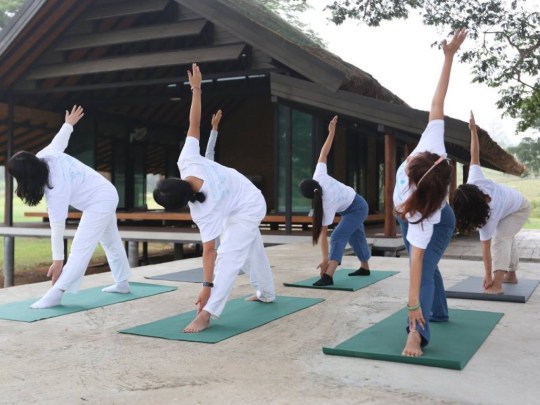
Are you seeking a transformative journey that rejuvenates your mind, body, and soul? Look no further than a viaje retiro espiritual. This mystical land is renowned for its ancient spiritual traditions, serene landscapes, and profound teachings. Join us on a 10-day adventure that will take you through some of India's most sacred destinations, where you can immerse yourself in spirituality, culture, and self-discovery.
Read some a spiritual retreat trip to India.
Day 1-2: Arrival in Delhi - Your spiritual journey begins in the bustling city of Delhi, where you will be greeted with warm hospitality and taken to your hotel. Take some time to rest and acclimate to the new surroundings. In the evening, enjoy a traditional Indian dinner and prepare for the adventures ahead.
Day 3-4: Rishikesh - The Yoga Capital of the World Travel to Rishikesh, nestled in the foothills of the Himalayas and renowned as the yoga capital of the world. Immerse yourself in daily yoga and meditation sessions by the banks of the holy Ganges River. Visit the famous Beatles Ashram, where the Beatles stayed in the 1960s and wrote many of their songs. Explore the vibrant markets and attend the mesmerizing Ganga Aarti ceremony, a spiritual ritual that takes place every evening.
Day 5-6: Varanasi - The Spiritual Capital of India Continue your journey to Varanasi, one of the oldest living cities in the world and the spiritual capital of India. Witness the sunrise boat ride on the Ganges River, where you can experience the mesmerizing sight of devotees performing their morning rituals. Explore the narrow lanes of the old city, visit ancient temples, and immerse yourself in the spiritual atmosphere of this sacred city.
Day 7-8: Bodh Gaya - The Enlightenment Site of Buddha Travel to Bodh Gaya, where Lord Buddha attained enlightenment under the Bodhi Tree. Visit the Mahabodhi Temple Complex, a UNESCO World Heritage Site, and meditate under the Bodhi Tree, following in the footsteps of Buddha. Explore the tranquil surroundings and soak in the spiritual energy of this sacred place.
Day 9-10: Agra - The Iconic Taj Mahal End your spiritual journey with a visit to Agra, home to the iconic Taj Mahal. Marvel at the beauty of this architectural masterpiece and learn about the love story behind its creation. Explore the Agra Fort and immerse yourself in the history and grandeur of the Mughal era. Reflect on your journey and the spiritual insights gained along the way.
This viaje a la india 10 días offers a unique opportunity to explore the rich spiritual heritage of this ancient land. Immerse yourself in yoga, meditation, and spiritual teachings as you journey through some of India's most sacred destinations. Experience the transformative power of India's spiritual traditions and return home with a renewed sense of purpose and inner peace.
Are you ready to embark on a soulful adventure and discover your inner zen? Look no further! We're delving into the world of Spiritual Retreats, where benefits meet breathtaking destinations and transformative programs. Whether you're an experienced spiritual seeker or simply seeking to recharge and reconnect, we've got you covered with all the essential information about these sanctuaries for the soul.
From tranquility to transformation, spiritual retreats offer a range of benefits. You can anticipate escaping the daily hustle, reigniting your inner spark, and learning mindfulness. The best part? The world is your playground! Healing Holidays, your trusted wellness expert, offers a plethora of spiritual retreat options worldwide. Get ready to explore the benefits, uncover unique programs, and set your sights on some of the world's best spiritual retreats – it's time to elevate your spiritual journey to new heights!
Benefits Spiritual retreats provide a sanctuary for the soul, offering a reprieve from the chaos of everyday life and a chance to reconnect with your inner self. These retreats blend serene locations, transformative programs, and mindful practices to offer a variety of benefits.
Stress Reduction:
Escape the grind and experience reduced stress levels. Mindfulness: Learn to live in the present moment with a sense of inner peace.
Self-Discovery:
Explore your inner self, gaining a deeper understanding of your thoughts and emotions. Rejuvenation: Recharge your physical, mental, and emotional well-being.
Cultural Immersion:
Immerse yourself in destinations and their spiritual traditions.
Healthy Lifestyle:
Adopt healthier habits that last. Community: Connect with like-minded individuals, forming supportive and lasting relationships. Destinations At spiritual retreats, you have the opportunity to visit peaceful and stunning locations. These include serene mountains, relaxing beaches, ancient temples, and modern wellness centers, all of which contribute to your well-being. These top picks from Healing Holidays provide the perfect backdrop for finding your true self and experiencing inner peace.
0 notes
Text
Buddhism: The Path to Enlightenment and Compassion
Introduction:
Buddhism, founded by Siddhartha Gautama, known as the Buddha, is a profound spiritual and philosophical tradition that originated in ancient India over 2,500 years ago. Embracing teachings of compassion, wisdom, and inner transformation, Buddhism has spread across the globe, leaving a lasting impact on countless lives. This article delves into the key principles, historical development, major branches, and its impact on individuals and societies.
1. The Life of the Buddha:
Siddhartha Gautama, born into a royal family in the 6th century BCE (563 BCE) in Lumbini (modern-day Nepal), renounced his privileged life to seek answers to the suffering and impermanence of life. After years of rigorous meditation and self-inquiry, he attained enlightenment under the Bodhi tree in Bodh Gaya, India, becoming the Buddha or "the awakened one."
2. The Four Noble Truths:
At the core of Buddhist teachings lie the Four Noble Truths. They are the truth of suffering (Dukkha), the truth of the origin of suffering (Samudaya), the truth of the cessation of suffering (Nirodha), and the truth of the path leading to the cessation of suffering (Magga). Understanding these truths is essential for breaking the cycle of suffering and attaining liberation (Nirvana).
3. The Eightfold Path:
The Buddha expounded the Eightfold Path as a practical guide to living a life of ethical conduct, mental discipline, and wisdom. The Eightfold Path consists of Right View, Right Intention, Right Speech, Right Action, Right Livelihood, Right Effort, Right Mindfulness, and Right Concentration. Practicing these principles leads to personal transformation and the realization of one's true nature.
4. Major Buddhist Schools:
Over the centuries, Buddhism diversified into various schools, each interpreting and emphasizing different aspects of the Buddha's teachings. The major branches include Theravada (the way of the elders), Mahayana (the great vehicle), and Vajrayana (the diamond vehicle). Each school holds unique practices, scriptures, and interpretations of Buddhist philosophy.
5. The Spread of Buddhism:
In the centuries following the Buddha's death, Buddhism spread across Asia, reaching countries such as Sri Lanka, China, Japan, Tibet, and Southeast Asian nations. Buddhist missionaries and traders played crucial roles in disseminating the teachings, leading to the formation of diverse cultural expressions and practices.
6. Buddhist Philosophy and Psychology:
Buddhism delves into profound philosophical inquiries about the nature of reality, consciousness, and the self. The concept of Anatta (non-self) challenges the idea of a permanent, unchanging self and emphasizes the interconnectedness of all phenomena. Buddhist psychology explores the mind's intricacies, offering insights into understanding and transforming negative mental states.
7. Rituals and Practices:
Buddhism encompasses a wide range of rituals and practices tailored to different cultural contexts and schools. These practices include meditation, chanting, offering ceremonies, and pilgrimages to sacred sites. Meditation, in particular, holds a central place in Buddhist practice, fostering mindfulness, tranquility, and insight.
8. Buddhism in the Modern World:
Today, Buddhism continues to thrive globally, attracting millions of followers seeking spiritual guidance, inner peace, and compassion. It has adapted to modern contexts while retaining its core principles. Buddhist concepts, such as mindfulness and compassion, have also found applications in secular settings, influencing psychology, medicine, and well-being practices.
Conclusion:
Buddhism remains a profound and influential spiritual tradition, offering timeless wisdom and practical tools for individuals seeking a path of self-discovery and liberation from suffering. Its teachings of compassion, mindfulness, and non-attachment continue to inspire millions, fostering a sense of interconnectedness and a deeper understanding of the human condition. As Buddhism continues to evolve and resonate with people across cultures, its enduring impact on personal transformation and societal harmony. (Next post will be published at 6PM IST) Read the full article
0 notes
Text
Bihar's Ancient Legacy: Exploring the Rich Cultural Heritage

Nestled along the fertile plains of the Ganges River, Bihar, India, boasts a timeless legacy steeped in history, art, and spirituality. Known as Magadha in ancient times, this culturally vibrant region was once the epicenter of political power and intellectual pursuits. Bihar's rich cultural heritage spans millennia, leaving behind a treasure trove of ancient ruins, majestic monuments, and sacred sites that continue to mesmerize and inspire people from all over the world.
The Golden Age of Magadha:
Bihar's cultural heritage can be traced back to the Vedic period when it was an important center of learning and knowledge. It was during this era that the two great ancient universities, Nalanda and Vikramshila, flourished, attracting scholars and students from distant lands, making Bihar a beacon of wisdom and enlightenment.
The Land of Buddhism:
Bihar holds immense significance in the history of Buddhism as it was in Bodh Gaya, a sacred town in Bihar, where Siddhartha Gautama attained enlightenment under the Bodhi tree and became the Buddha. The Mahabodhi Temple Complex, a UNESCO World Heritage Site, stands as a testament to the enduring legacy of Buddhism in the state.
Historical Capitals:
Bihar served as the ancient capital of various powerful dynasties, including the Mauryas, Guptas, and Palas. The ruins of Pataliputra (modern-day Patna), Vaishali, and Rajgir are reminders of the opulence and grandeur that once adorned these historical capitals.
Architectural Marvels:
Bihar's cultural heritage is resplendent with architectural marvels. The Great Stupa at Kesaria, built during the Maurya period, is one of the largest brick structures in the world, exemplifying the advanced engineering and architectural skills of ancient times.
Timeless Traditions:
Bihar is a melting pot of diverse traditions and festivals. Festivals like Chhath Puja, observed with great devotion and reverence, highlight the deep-rooted cultural practices and the state's spiritual connection with nature.
Folk Art and Craftsmanship:
The state's cultural heritage is also evident in its vibrant folk art forms and traditional craftsmanship. Madhubani paintings, Sikki crafts, and Sujini embroidery are just a few examples of the artistic brilliance that has been passed down through generations.
Living Heritage:
Bihar's cultural heritage is not confined to ancient ruins alone; it lives on through the customs, rituals, and daily lives of its people. Folk music, dance, and theater continue to captivate audiences and preserve the essence of Bihar's cultural traditions.
Literature and Language:
Bihar has a rich literary heritage, with numerous scholars and poets leaving behind an indelible mark on Indian literature. The language of Magahi and the works of renowned poets like Vidyapati add to the literary richness of the state.
Folklore and Legends:
Bihar's folklore is filled with fascinating tales and legends that are deeply woven into the fabric of its culture. These stories reflect the wisdom, values, and beliefs cherished by generations of Bihar's people.
A Journey of Rediscovery:
Bihar's ancient legacy is an invitation to explore the wonders of an illustrious past. As tourists and history enthusiasts traverse the length and breadth of the state, they unearth the untold stories, architectural wonders, and cultural gems that continue to inspire and leave an indelible imprint on their hearts. Conclusion: Bihar's cultural heritage stands as a testament to the richness of India's past. With its ancient universities, architectural marvels, and spiritual significance, the state is a treasure trove of history, offering a glimpse into the brilliance and ingenuity of our ancestors. Preserving and celebrating Bihar's cultural heritage is not only a matter of pride but also an essential step towards embracing our roots and nurturing our collective identity. As we marvel at the beauty of this timeless legacy, let us ensure that it remains cherished and protected for generations to come. Read the full article
1 note
·
View note
Text
Bodhi made weird hours. It was the con (and sometimes pro) of the job. Whenever he made inquiries he had to make sure his targets were at home, and with most of the population having regular day jobs, it meant he usually slept during the day just so he could be out around breakfast and dinner to follow leads. Fenrir’s Wood might be saved from the Godly ritual that the Children of Loki had brought upon them all, life went on. And he still believed that Zhyan was out there, housing the spirit of Hel, despite all research into the subject had followed with the message that the Witch had died.
But life went on. If anything, Fenrir’s Wood was just like a regular place in the UK: just with a few more chicken murders.
He brushed his thick hair back as he entered CoffeeKanteen, eager to fill up on his daily dose of caffeine so he could brave the streets later on looking for someone’s nineteen year old child. He’d searched all the places his parents said he could be, but no luck yet. It had only been fourteen hours, so he wasn’t worried yet, but he still took on all the cases of disappearing people far too seriously. Loki’s children might’ve been defeated: there were still too many people missing.
However, thoughts of his most recent case completely disappeared from his mind when he saw a familiar face seated at one of the tables. He frowned in surprise, smiled and gave her a little wave, as he walked to the counter to get a double espresso.
Once supplied, he walked back to the table and gestured at the chair. “May I sit here?” he asked. Not the first question that came to mind, because he did want to know how she was doing. She seemed better than last time he’d seen her, but that could just be surface level.

Stalker Much || Sofia&Bohdi
♚ She'd done it a few times now. On days when she didn't have work and Micah did, when Nohemi was busy with school. Maybe it was weird. Or rather it was definitely weird. Still Sofia was sat in the same coffee shop where she had found herself distraught, waiting for her sister, and comforted by a stranger. She'd never got his information, not his phone number, not even a full name, so she'd not known what to do to reach out. Other than sitting in that same cafe whenever she could, hoping he might simply stop by. The town was small enough that she thought...maybe.
♚ Each time she brought with her a container of cookies, or 'biscuits' as they seemed to keep calling them in Fenrir, and probably the rest of the UK. The current was a typical cookies, Oreos, however it was potentially an unfamiliar flavour - Dirt Cake. She hoped they would amuse him, if that was all they did, but she knew there was more to why she was so set on meeting him again. Trust.

♚ Even as she sat there, contemplating how crazy it was that she was essentially stalking this grown adult man - that she still believed she could take in a fight - she couldn't will herself to leave, because people she trusted was something she felt she was lacking since her arrival. Bohdi's actions had been selfless, so far as she had assessed, no repercussions had come of sharing with him, he hadn't spoken to her for self interest, or the interest of some ruling body. Sofia just wanted to feel whole in the town and while she liked Nish she didn't trust him, and while she knew Topher's intentions were good she also knew it would be fucked to put the entirety of her security in the town on one person. Afterall, Sofia knew while it would be unfair to Micah and Nohemi they would leave if she put up a fuss, they didn't help her feel welcome the way she knew she needed to so she could call Fenrir home.
♚ With a deep inhale Sofia raised her gaze, looking to the door as a bell chimed to signal someone entering.
@bodhimohan
#convo.sofia#convo#//the way I already ADORE this thread ;-;#stalker mention tw#disappearances mention tw
20 notes
·
View notes
Text

Maha Vairocana - Cosmic Sun Buddha Talon Abraxas
Vairocana is one of the Five Dhyani Buddhas created by Adhi Buddha. In Sanskrit, the name vairocana means "luminous" or "embodiment of light". In Chinese, Japanese, Tibetan, and Vietnamese Buddhism; Vairocana is called as Dari Rulai / Piluzhena Fo, Dainichi Nyorai, Nampar nangdze / Namnang, and Dai Nhat Nhu Lai respectively. In the above mentioned Buddhism, the Buddha is seen as the embodiment of Buddhist concept of Emptiness. While in Mahayana and Vajrayana Buddhism, Vairocana is considered as a Primordial Buddha and is located at the center. He is also referred to as the "great illuminating one," “the Life force that illuminates the universe," and importantly, "all-encompassing Buddha". Therefore, Vairocana is mentioned in different sutras.
In Brahma Net Sutra, it is written that Vairocana Buddha is seated on a top of a lotus pedestal and surrounding of that lotus there are thousands of flowers. These flowers are the Sakyamuni Buddhas, which supports a hundred million worlds. It is also mentioned that Sakyamuni Buddha is born in each world. They all attain Buddhahood at the same time under Bodhi tree. All these Sakyamuni Buddhas have Vairocana as their original body.
In Flower Garland Sutra, also called Avatamsaka, Vairocana is presented as the ground of being and the matrix from which all phenomena emerges. He is regarded as the Dharma Body of the historical Buddha (Siddhartha Gautama).
In Samantabhadra Meditation Sutra, also called as the "Sutra of Meditation on the Bodhisattva Universal Virtue", Vairocana is mentioned as a Buddha who has similar characteristics as that of Sakyamuni Buddha. And he roams around a place called "Always Tranquil Light".
Lotus Sutra, also called Saddharma Pundarika Sutra, is composed in the first century B.E.C. In this sutra, it is believed that Buddhas are said not to die even though their physical bodies degenerate. It is also mentioned that Buddha has explained that he has always lead the beings to their salvation and will always continue to do so. Therefore he is considered as the most sublime or truest reality in the universe.
In Mahavairocana Sutra, Vairocana is depicted as the universal Buddha from whom all other Buddha are originated. He is also represented as the source of enlightenment who helps others to be free from causes and conditions. It is also mentioned that Vairocana taught about the Dharma to Vajrasattva but it was incomprehensible to learn for them. That's why Vairocana provided esoteric techniques and rituals to help Vajrasattva to conceptualize the Dharma beyond verbal form. Therefore, Vairocana is also referred as a teacher, without whom there would have been no Buddhism, and also there would not have the path to enlightenment.
Even though Vairocana is mentioned in various Sutras, the doctrine of Vairocana Buddha is largely based on the teachings of the Mahavairocana Sutra. This Sutra is thought to be the earliest comprehensive manual of Buddhist tantra. It is believed that this Sutra is composed in the 7th Century.
Iconography
Vairocana Buddha is often depicted as seated in the lotus pedal which is supported by a pair of two great lions. Symbolically, it is represented that when the lions roar, all other remains silent and listens to him. Likewise, when one is spreading Buddha's teachings almost all others remains silent and listens to the Buddha's valuable teachings. When Vairocana Buddha is depicted as meditating, it is believed that the image of Vairocana helps to transform the delusion of ignorance into the wisdom preached by the Dharma. Similarly, when Gautama Buddha turned the wheel of Dharma, it illuminated the hearts of people which was darkened by ignorance.
When Vairocana Buddha is depicted in Buddha statues, he is also shown in Dharma chakra mudra. This mudra is formed when the thumb and index finger of both hands touch at their tips to form a circle. The left hand faces inward which covers the right hand which is facing outward and the hands are held against the chest. The remaining fingers of both hands remain extended.
Since Vairocana is believed to be the aggregate of all the Dhyani Buddhas. Therefore, He has the complexion of pure white since white produced when all the colors merge together. His symbol is the dharma wheel. When all Five Dhyani Buddhas are depicted together in a mandala, Vairocana is placed in the center. He is often shown larger than other Buddhas around him. He is Lord of Akanistha Ghanavyuha Pure land which existed in the center. His consort is White Tara and his Bija starts with Om. In Vajrayana Buddhism, it is believed that Vairocana Buddha helps to overcome ignorance and delusion when a person chants his mantra. Vairocana Mantra : Diamond Realm:Om。bie-zha-da-du。fan。 Womb Realm:Ah。e。la。hum。kan。
20 notes
·
View notes
Photo
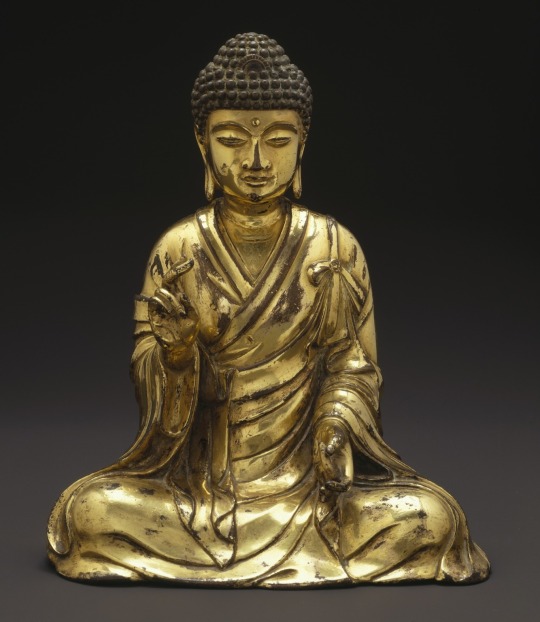
Next month we'll be unveiling a brand new gallery devoted to the arts of Buddhism. The installation will juxtapose artworks from various regions and periods, and feature nearly seventy objects from fourteen countries dating from the second century C.E. to the early 2000s. Many of the works are sculptural depictions of Buddhas, as well as ritual tools and ornaments made for Buddhist temples, a selection of paintings, and several of the Museum's master works. The gallery opens January 21, 2022, and is the latest in a series of new galleries for the Museum's Arts of Asia and the Islamic World collections.
Seated Buddha Shakyamuni, 965 or 1025. Gilt bronze. Brooklyn Museum, Gift of the Asian Art Council in memory of Mahmood T. Diba and Mary Smith Dorward Fund, 1999.42. Creative Commons-BY
#Bodhi tree#Bodhi Day#Buddhists#Buddha#arts of buddhism#Buddhism#brooklyn museum#bkmartsofasia#buddhist art#sculptural#tools#ritual#ornaments#temples#paintings
38 notes
·
View notes
Photo

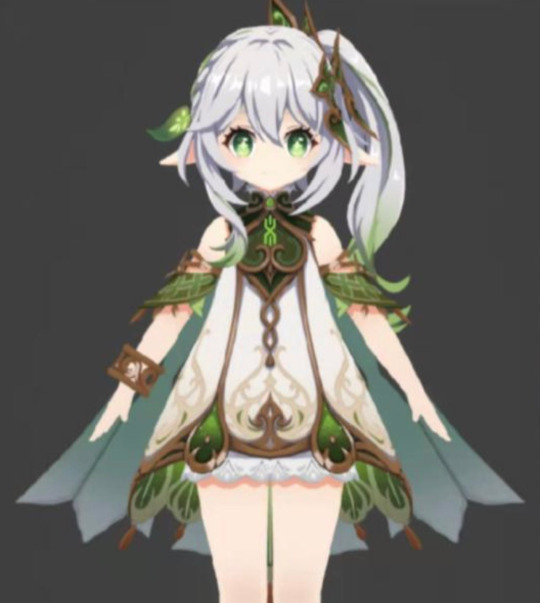
After the horrendous design of the dendro archon was leaked, it was only a matter of time until I took things into my own hands and redesigned her. Left is my design, right is whatever monstrosity mihoyo made.
I decided to go ahead and not make her an adult, because so many amazing artists have already done that for her. Instead I wanted to keep her the same age while making a design that's not. Western fairy child.
If you take offence at the fact that I redesigned her or am “disrespecting” the original, See Yourself Out.
Design notes under the cut because I have a mini essay here
Kusanali’s name (via leakers), “Nahida'' is likely derived from “Nahid”, a derivative from the Zoroastrian goddess Anahita. However, the title “Kusanali” itself is of buddhist origin, from the Jataka Tales specifically. Keeping both these names in mind, I wanted to make a design that referenced both Anahita and the Buddhist influence on Nahida.
The first step was figuring out how much influence buddhism had on the persian empire and it was.. not a lot. Only the eastern part of the empire was influenced to some small degree. I then narrowed down the time of spread to when the Parthian empire was a major power.
With an empire spreading all the way from modern day Iran to Pakistan, it should be obvious that the cultures it covered are all not the same, and this isn’t even getting into how diverse the ethinic groups are. We do not randomly mash the most “aesthetic” cultures together here sir.
I was using the buddhist hotspot city of Gandhara (marked roughly with the white X) as a point of reference for where to take design inspiration from.

Since Parthia was too far north from Gandhara, it would have been less influenced by buddhism. A friend stepped in and helped narrow down prominent regions that Parthia was allied with, and they finally located the one that was closest to Gandhara (circled in white).

The Sistan and Baluchistan region is populated by the Baloch people of Afghanistan + Pakistan, with clothes having a very distinct embroidery style. I referenced the basic silhouette of the clothes and jewelry from them but took some liberties with the embroidery itself.

The pattern I made for the dress was made using a peepal/bodhi leaf as base. The bodhi tree is symbolic of Buddha’s enlightenment. You can also see the leaf’s shape in her necklace and headpiece as well.
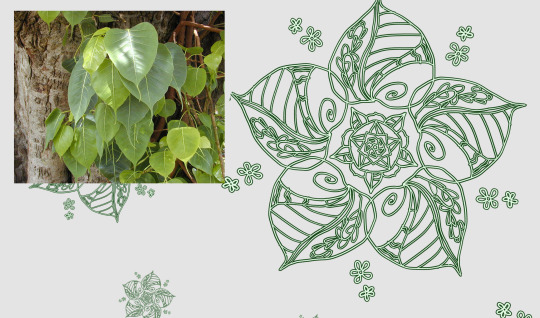

The other buddhist elements I used were how sculptors drew the lotus the buddha sits on with her slippers, and her earrings. To my knowledge, plain hoops are not a commonly used style, but I wanted to draw parallels to how the buddha’s ears are shaped in sculptures.
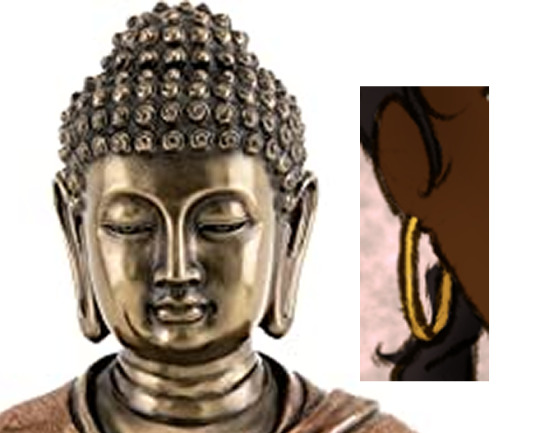
Anahita’s influence is more apparent in my colour choices. This extract describes how she looks;
She is regularly depicted as a beautiful woman in a white gown embroidered with gold, wearing golden earrings with a gold necklace around her throat and a golden crown. She carries the barsom twigs of life in one hand (representing the bounty of the earth and, so, fertility) and drives a chariot drawn by four horses of wind, rain, cloud, and sleet.
Hence the gold jewelery and white base clothes. No this is not a Saraswati reference because the two goddesses are Not The Same.
Finally her henna, when I looked up barsom, I found this Zoroastrian ritual tool by the same name that holds the barsom/barsam/myrrh twigs. I referenced the crescent shape of the tool in Nahida’s henna, and looked at other henna designs in order to create it.

#genshin impact#genshin impact sumeru#sumeru#genshin Kusanali#oc: Nahida#yes this is my child now#genshin
104 notes
·
View notes
Note
((Ooooh, I love that there are so many options and things that can be done with the tags! It's such a neat way the programs can express themselves and their connections! I love that they can choose to modify them in a way that fits their personal preferences!
And, I love that they can integrate parts of User ceremonies, too - it really is unique to pairs of what things they do to show their bond.
Oh wow, Beck really had a lot on his plate! And oh nooo ouch about him still having Bodhi's tags. Maybe one day he'll be able to heal more.
Oooo, yeah, that makes sense that it's pretty involved to alter circuits. I like that there's a waiting period to make sure the potential random changes finish up first. I like the possibility of a ritual, but that's interesting that most programs skip it and jump right in.
Aaaaah, oh man, yeah, Clu can't create things, only corrupt and destroy to make them as close to what he wants as he can get.
If a pair has no involuntary or voluntary circuit changes and only relies on tags or jewelry or something to indicate their status, is that looked on differently than pairs that have circuit changes?
Ooooh, the pre-programmed platonic bonds are super neat and I like that they span a whole range of possibilities! (Aaaaah, poor Cyrus!) I love that they're different on Encom, too, and the security hive mind is fun! (Does Tron miss the hive mind or is he thankful that there's not one on the Grid?) Would security programs deep in the hive mind also be able to have other bonds as well?
Oh, that's so much fun that there's lower level tags for shenanigans! Is there a limit to the number of tags a program can have active? (Like if their friends just loaded them up and filled their tags to max as a joke?) Can any program tag another program? Do Monitors tag particularly pesky troublemakers to warn everybody/other Monitors? Can some tags be filtered to secret, so that you have to be in the know or something to see them?
Do tags made by Users have any different properties? If a User isn't a programmer, are they still able to make tags? Is there a distinction between tags made by Basics and ISOs? Is it seen as weird if somebody has no tags at all?
Thanks!))
((Oooh, I enjoyed reading your thoughts on program bonding! I have some questions I'd like to see your take on, if you don't mind! ^_^ Would programs who have damaged code and/or have been rectified have difficulties with bonding, or do they work around it by sharing the non-damaged/non-Occupation code? Does bonding differ between Basics and ISOs? Can programs and Users bond? Also, what would happen if one half of a bonded pair died/got rectified/became a virus? Thanks! <3 ))
Good questions!!
Programs who have damage (and rectification counts as a type of damage, since it's corruption/forced alteration) have a little more difficulty than their intact contemporaries with bonding - though this depends on how deep the damage runs. You can split this into two main categories :
Core damage : what it says, their core is damaged. They'd have to share an undamaged part, and finding or isolating those could be incredibly difficult. Most Programs with core damage would use a method more like tagging their energy field with a label than actually exchanging code.
Non-core damage : finding undamaged core code? No problem. Making sure your core is compatible with the introduced bits from the partner... much more problematic. They could end up having a nasty reaction, as their internal defences read the introduced code as an attempted hack.
ISOs and Programs bond the same way, but cross-bonding between the groups is rare due to compatibility issues.
Programs and Users can tag each other's energy fields, but core-deep bonding is impossible. The Program in such a couple may willingly modify their core code to be unable to function without their User, but as a User doesn't have core code the same way (DNA is too complex to mess with) the User can't exchange it with their partner. An ISO and a User are more compatible this way, but are more likely to follow User customs than Program ones.
For a bond to break in those ways...
Death : the remaining Program would drift through almost Stray-like, barely functioning, until someone put them out of their misery or they followed their partner. It's cruel and upsetting for everyone involved, and most bonded Programs go permanently offline within a few minutes of each other.
Rectification : this is one of the few scenarios where it does not end in the Occupation's favour. If one Program is still unrectified, they can pull their other half back from it - rectification can't alter core code, though it can affect everything else, so they recognize each other and a skilled enough medic-hacker can perform the necessary operations to undo what was done to them.
Virus/corruption : ends one of two ways. Either the same as rectification, or now you have two Viruses happily bonded and gleefully corrupting everything they can get their hands on together. Toss of a coin for which result happens, although Monitors and other Security builds are more likely to join their partners in Virus-dom than the standard Program on the street.
Derezolution : while on the Legacy Grid this is effectively the same as death because Programs tend not to get re-rezzed (since the sole User is in hiding and this would be the quickest way for someone to find out where he is), on the Encom Grid Programs reactivate from backup pretty often. As long as the backup includes the bonded code/tag, it's like nothing happened. At most, there will be a shiver down the spine of the one who remains that doesn't go away until their other half reactivates. If the backup does not include the bonded code, the remaining Program is drawn to their partner's backup and they re-bond.
24 notes
·
View notes
Text
First Lines
Rules: Don't reblog this post, make a new one! List the first lines of the last ten (10) stories you published. Look to see any patterns you notice yourself, and see if anyone else notices any. Then tag some friends.
Vivea still looked elegant, even in death. (Convergence)
Nyll Siluva always reminded herself that it could be worse. (Empty Places Between Stars)
It wasn't often that Luke Anderson, orthopedic surgeon and committed healer, wanted to kill someone. (If I Can't Let Go)
Antoc Merrick was not pleased with his involuntary accommodations. (Unthinkable)
The sun was sinking low over Padua as Don Pedro rode through cobbled streets with white-walled buildings and red-clay roofs. (Dessert)
The little organic in the drab-grey uniform that all the Imperial-aligned organics wore was a very bad saboteur. (A Very Bad Saboteur)
"Will you have me, lady?" Don Pedro asked, with a little smile curling at his lips, completely interrupting the flow of their banter. (Another for Working Days)
Sam was getting used to there being a white boy on his sister's couch. (Found in the Falling)
"That looks absolutely radical!" Fitzroy Maplecourt, former Knight (in absentia) of the realm of Goodcastle and current successful entrepreneur, declared. (Ritual Betrothal Conquest)
Hello Love, I'm thinking about legacies and destiny. (Selected Readings from the Physical Documents of Bodhi Rook)
This wound up being really interesting to me. I clearly favor having the POV character's name in the first line (6/10 - and when it wasn't the POV character, it was almost always them observing the other MC). I also favor emotion and thought over setting (WHAT A SURPRISE, if you know my writing at all) - Dessert is one of the only ones that has setting in the first line, unless you count the vague mention of Merrick's accommodations.
I think my favorite is #3 - introduces the character and has some humor to it as well. I also find it funny that #10 snuck in with epistolary - still more about feeling over setting, though.
I saw @r0b0tb0y 's and thought it looked fun, and then found the post was helpfully tagged to YOU, so I decided to take that seriously and go ahead and do it. I'm returning the favor, and tagging YOU. Tag me if you do it! I'm curious.
12 notes
·
View notes
Text
Home Bound

Survive. Escape. Go home? To what home?
Jyn and Cassian escape from Scarif and settle on a small planet in the outer rim where the traditions are vibrant and the Rebellion barely scratches at their front door. Years pass, they live. But then the scratching at their door gets heavier, and heavier, and soon there’s a knock that calls them back into the service. They go because to say no would go against their very fiber, but when everything they’ve come to know disappears, how do they remember what they’re fighting for?
Survive. Escape. Go home. Right?
A gift for the Rebelcaptain Secret Santa gift exchange for @youareiron-andyouarestrong!
Read it all on AO3!
Part One:
Step 1: Survive.
Step 2: Get off Scarif
Step 3: Get back to Yavin V
Step 4: …. Step 4?
They make it through steps one through three and he doesn’t understand how exactly it happens. One second he’s on a beach and the sky's alight and the heat is almost unbearable but for her body wrapped around his… Next, he’s tucked in a medbay bed on a ship with his hand wrapped up in Jyn’s, her grip tight despite the soft breaths filling his room. He doesn’t know what’s supposed to come next and for once, maybe he’s okay with that.
And so he pulls her hand closer and ignores the twinge in his spine as he wraps himself around her, unwilling to let the heat from before eat him alive like his mind is convinced it will.
---
They settle on Calabriana, a small planet in the Outer Rim where nobody knows their names. The anonymity was a requirement after Scarif, after the desolation of Yavin V, after Hoth.
Cassian and Jyn had stuck around the Rebellion after Scarif to fight and it had been years of it, endless days of missions that had picked at their open wounds until one day - a day like any other - Cassian had come back to his bunk to find Jyn curled up in his cot, shivering and vacant.
“Jyn?” Cassian breathes, hesitating at his door. It wasn’t that she was here, in his room, which made him pause. Nor was it finding her in his bed, even though they never explicitly talked about that . No, the panic in his chest wasn’t any of those things. It was the look on her face, the way it didn’t flicker to life like it normally would. Something was wrong. “Are you alright?”
She doesn’t respond, not verbally at least. All she does do is close her eyes until her brow furrows and her breathing seems to stop under his inspection. It's enough to bring him to her side, his hand coming to her cheek as he drops to his knees beside her.
“Come back to me,” he whispers softly, the words unfamiliar on his lips.
They had always been her words, murmured into his temple after a bad dream, after a mission went sideways and she had to come find him. Her fingers on his chin, her cheek pressed to his brow so he didn’t have to hide his pained expression.
“Jyn, come back,” he repeats and her eyes blink open, flickering up to meet his. He exhales a shaky breath and slides his thumb along her jaw. “Do you want to talk about it?” She shakes her head and he follows as she pulls him into the bed, her small frame tucking into his chest as though she was set to disappear into him.
An hour passes. Then two. It’s late when she whispers what she needs, the feeling resonating within him like a ricocheted gunshot.
“I can’t be here anymore. I need to leave. Come with me?”
He doesn’t think before he utters his reply: “Yes.”
It’s two days later that they’re boarding their ship, the half-repaired K2SO droid packed away and their small bag of worldly possessions fastened in the hold.
Leia had come to say goodbye, as had Draven and Bodhi and Kes. Their small farewell had gone mostly unannounced. The heroes of Scarif disappeared into the sky, almost as though their lives in the Rebellion after Scarif were but ghosts haunting hallways. Maybe they had been.
---
Life on Calabriana was hard. Not in the sense of working themselves to death or being required to go on high risk missions every day like an endless rotation of pain and misery. No. It was hard in the way that living a quiet life after so much suffering was hard. It was the silence, and the calm way that life moved like a snake in the grass, weaving and slithering through time until it rounded in and tried to consume itself.
At first, Cassian was sure they’d made a mistake. His hours helping build a home were well spent, yes, but the nights were almost unbearable. There was no intel to keep his mind occupied when the nightmares wouldn’t cease, no halls to endlessly walk until he fell asleep on a crate or in a corner hidden from view. On Calabriana, there was only silence and the creak of the floors under his feet, Jyn’s bedroom door always closed as he debated raising his fist and disturbing her sleep. He doesn’t, at least not until one day she pulls it open and reaches for his hand, drawing him into her room and into her bed.
Neither of them say it out loud but every sleepless night from that night on - and even some in between - ends with finding solace in one another’s arms. And then one night, as Cassian hovers in her doorway as she readies for sleep, he straightens and finally pulls himself together.
“I don’t want to sleep in my own bed anymore,” he admits, cautious and low.
“I thought we already gave up on that idea,” Jyn answers evenly, pulling her work top over her head and tugging one of his old shirts from her drawer to use as a nightshirt. The hem hovers mid-thigh and he forces himself not to stare even though his whole body lights with the familiar draw of her.
“Really?” He counters and she lifts a brow in reply. In another second she’s standing before him, hands on her hips in challenge.
“Really. I asked you to leave the Rebellion with me and you did. I never really understood why you thought you needed to sleep in another room but I wasn’t going to push you. Figured you’d come around eventually.”
“You mean you were already at this point and I’ve been the one holding back?” The thought surprises him, all of the signals for the reality of their arrangement finally falling into place. Oh .
“Maybe,” she smirks and he sighs, reaching for her hips and drawing her close to his chest. The kiss is anything but chaste and in the morning when they wake - wrapped around one another like vines on a lush jungle planet - they don’t talk about how things have changed and what it means, instead choosing to simply share a room like it was a practical merging of resources.
---
Sharing a room becomes sharing a life. They work the fields together, go to town together, and when the nights are particularly cold with the seasonal change they cling and make their own heat together.
Their first few months on Calabriana pass uninterrupted by guests until one night there’s a knock on their door, a stricken look passing over Jyn’s face as Cassian gets up from where he’s settled with a story and his tea. He hesitates at the door, sucking in a breath, before he pulls it open to see a small crowd of humanoid beings huddled outside in elaborate colourful costumes. The sight makes him uneasy until one takes a breath.
And then they start to sing.
It’s maybe only five minutes. Maybe ten. Before the group nods and bids their farewells, walking off into the night as Cassian shuts the door and turns back to face Jyn who looks just as confused.
“Local greeting committee?” Jyn offers with a shrug. Cassian nods and returns to his seat, picking up his reading and trying not to think about the odd encounter.
A few days later and Jyn and Cassian venture to town, their eyes wide as they come upon the village now lit with endless flickering lights and colours all strewn about the streets. All around them people are rushing from shop to shop, arms loaded with bags and bright smiles on their faces.
“What's going on?” He asks the supply clerk nonchalantly, his attention turned towards his chip card as he swipes it across the reader.
“It’s the season of Jule. A time of gathering and well-wishing. Have you never experienced a Calabrianan Jule before?” Cassian shakes his head and glances over to where Jyn is running her fingers along a scarf on display, her lips quirked up in a small smile. “Well, it is a wonderful time to be here. You must attend the feast. Three days from now in the market - bring your partner and gift her that lovely piece she’s admiring - it’s tradition.”
“How much for it?” Cassian asks by way of thanks. The man adds the cost to his bill and promises to wrap the gift up ahead of the festival.
Cassian doesn’t know what he’s promised to attend - was the feast a sacrificial ceremony or truly a happy occasion, he wasn't sure - but he isn’t concerned. None of the research he’d managed to dig up on this planet had talked about ritual sacrifice, so they’d probably be fine.
He hoped, at least.
---
The day of the feast, Cassian has to challenge Jyn to a competition to get her out of the house. She's too busy lounging like a Lothkat, curled up under a blanket as she enjoys her tea and hides away from the chill that has settled outside.
"I'll do the dishes for a week if you win. If I win, you have to come with me to town later," he offers, tweaking her toes with his fingers until she grins and pulls them out of his grip.
"Fine. Get the dice."
He wins by sheer luck, or at least that's what he tells himself as she rolls another snake-eyes. Two hours later and they're back in town, coming upon the small community at dusk. The lights flicker across the growing darkness and Cassian swears he can see stars in Jyn's eyes, her look of awe beautiful and serene and so far from the haunted look she'd worn the day she asked him to leave with her.
"They say there's a feast," Cassian says easily, starting to lead them forward and through the small alleys towards the market. Jyn sticks to his side and keeps her hand curled in the fabric of his pocket, holding on as they weave between groups of people, little families sprawling across swaths of space.
"A feast of what, exactly?" Jyn counters evenly, though there's no harshness to her words.
"Not sure. But the guy at the shop said we should come and I figured… if we're going to settle here we might as well try to follow some of their customs to blend in. Unless - "
"No, you're right. We can keep to ourselves but I think eventually we need to engage a bit. Good call," she adds. Cassian laughs tightly and reaches for her hand, pulling it into his own.
"Don't congratulate me yet, we've still got to survive tonight."
They arrive into the bustle of the market and are stopped short by the sight they come upon. It's like Home Base after a victory, the crowd thriving and music filling the space around the shouts of excitement. A giant tree fills the center of the square, its bows filled with lights and ornaments that sparkle and glint in the changing light. Around them, children chase each other and adults fill tables with food and drink and laughter. It feels foreign to stand on the edge, looking in at a community that wasn't theirs.
"You made it!" The clerk greets, lifting himself from his table and beckoning them over. Cassian clutches tightly to Jyn's hand and seeks her approval with a glance, her returning squeeze urging them forward. "And you've brought your lovely partner. Sit! Join us!"
They're settled into seats at the crowded table and handed cups and a bottle of something tangy. Jyn seems to evaluate the substance before pouring herself some and dipping a finger in for a taste. Cassian watches as she frowns and then softens to an easy smile, eventually lifting to take a sip. With her approval, Cassian pours himself a cup and let's the man - Hinar, as he introduces himself - bring them up to speed on the celebration.
Twelve nights of celebration. Food, family, friends as a theme with occasional gifts given to each other on the last night. An ancient tradition brought from across the universe and combined into one massive festival celebrated around the small planet.
The whole thing awed Cassian, the joy and the brightness and the welcoming nature of everyone around them. He'd never seen Jyn laugh so freely and the lightness of it was contagious, filling him too and loosening his tension for the first time in months. This was a planet still untouched by war, its few resources and minimal population making it unattractive to those looking to bleed a planet dry. They would be safe here, he was sure of it, or at least that's what he told Jyn as they wandered home a bit tipsy and a bit light on their feet.
"I think we could build something here," he murmurs as she leans into his side, the navy scarf he'd gifted her wrapped loosely around her neck.
"What do you mean?" It's not accusatory and he thinks that's good, right?
"If… if you wanted to make something out of the rest of this life. Together. I think we could do it here."
She slows her pace as they linger in the yard, her gaze finding his in the low light.
"Are you asking me to - "
"Yes. Whatever we want it to be. But I want to build it. With you."
Her eyes stay locked onto his, the colours swirling in the low light as she chews the inside of her cheek. The silence is almost deafening and he nearly takes it back, the proposal burning the back of his throat.
But then she lifts up on her toes and reaches her arms around his neck, drawing him down towards her waiting lips.
"Yes," she whispers later into his chest, her body perched over his as he slowly comes down from his release. Her sweaty sticky skin slides across his and she wraps herself around him, their breathing coming into sync. “I want to build something. With you.”
He thinks maybe this was what Step Four was about, all those months ago.
#youareiron andyouarestrong#rebelcaptainsecretsanta#therebelcaptainnetwork#rebelcaptain#rebelcaptain fic#lollercakes tries to write
21 notes
·
View notes